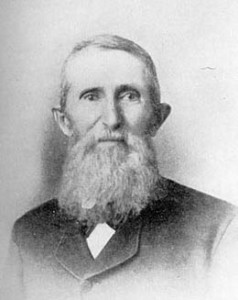Tacoma hasn’t been the City of Destiny for very long, historically speaking. But that is not unusual. Americans and Europeans didn’t settle in the area, even after several explorations of the area dating back centuries. Those adventurers came and went.
White settlers really didn’t start calling the Pacific Northwest their adopted home until the mid-1850s, and even once they started settling down, things were shaky. That fact makes the simplistic historical statements around “firsts” a bit wishy-washy.
Such is the case with Job Carr and his now famous cabin-turned-museum in Old Town Tacoma. The site is credited as the first permanent residence of a settler in what is now Tacoma.

Carr’s storied place in Tacoma’s history started on Christmas Day of 1864. He arrived on Tacoma and filed a land claim for 168 acres in what is now part of the city’s waterfront walkway along Commencement Bay.
Don’t get any ideas, however, that Carr was some pioneer staking his claim in the untamed wilderness. History is rarely that simple.
A man named Peter Judson had filed a 321-acre claim in the area back in 1853. He picked this site because it was located next to a sawmill that Nicholas Delin built the previous year. Judson isn’t credited as the first pioneer, since he would only live on the land for two years, abandoning the site in 1855 with the start of the Indian War that threatened isolated settlements and homesteads around Puget Sound. He would not return to his land, on what is now between 7th and 20th streets, when the war ended with the Treaty of Medicine Creek the following year. He largely disappears from local history after that.
That marks Carr the “first settler,” even though he didn’t arrive until a decade later.
Carr was not the stereotypical Old West settler that has been made famous by movies. First of all, he was 51 years old when he arrived. He was an old man by standards of the day and had already been married and had children. He was a wounded veteran of the Civil War. He was an anti-war Quaker, but abhorred slavery more than violence. He was wounded twice in battle.
News of a transcontinental railroad fed into his thirst to reinvent himself, so he set his sights on land where the railroad would eventually stop: Tacoma. But those trains wouldn’t come for another few decades.

Carr scouted sites around Puget Sound and selected his claim in what is now Old Town and North Slope because it provided great fishing and supplies of fresh water so close to what would be a boom town with the arrival of the rails. His cat Tom served as his only companion. Up sprung his two-room cabin, but it wasn’t until the following fall that the dwelling actually got a formal roof. That came with the arrival of his eldest son, Anthony, in September of 1865. His younger son, Howard, would help add a porch a year later. In the years that followed, Carr would be joined by his two daughters, Marrietta and Margaret, as well as his ex-wife.
The growing homestead would not be Carr’s for long however. He sold all but five of his original 168 acres to Matthew Morton McCarver in 1868. But Carr and his cabin didn’t fade from history the way Judson largely did.
The cabin would serve as the city’s post office in 1869, with Carr taking the title of Postmaster. Since the post office made the cabin a governmental facility, it also became a polling station when residents found themselves voting for the formation of Tacoma. Carr was appointed the city’s first mayor.
While Tacoma was selected as the terminus of the transcontinental railroad, the Northern Pacific Railroad opted for a site close to the harbors, at what is now Tacoma’s Stadium Bowl. In 1883, the railroad system created “New Tacoma” and the settler-created “Tacoma City” merged to form one city. That put Carr’s cabin in “Old Town,” a name that remains to this day.
Carr would die four years later. He was 74, but his descendants still call Tacoma home.

A replica of the Carr cabin was built in 2000 and now serves as a museum to the early days of Tacoma as well as a focal point of community events.
Walking tours of the site and the surrounding neighborhood are scheduled this summer. The first of four tours will start at 11:00 a.m. on May 14 and address early immigrants to the area.
The second tour will begin at 11:00 a.m. on June 11 and focus the working waterfront. The third tour will be held at 5:00 p.m. on July 13 and focus on Tacoma’s frontier days. The final tour will begin at 5:00 p.m. on August 17 and focus on Old Town in the early 20th century. All tours are pay-what-you-can and begin at Job Carr Cabin Museum, located at 2350 N 30th Street in Old Town Tacoma. More information is available online at jobcarrmuseum.org.
May is Historic Preservation Month, so there are a host of other events highlighting Tacoma history. One citywide event will be the second annual Amazing Preservation Race on May 14, when teams will experience a local version of the hit television reality show to learn about “Secret Tacoma.”
More information about historical events can be found at cityoftacoma.org/hpevents.





































